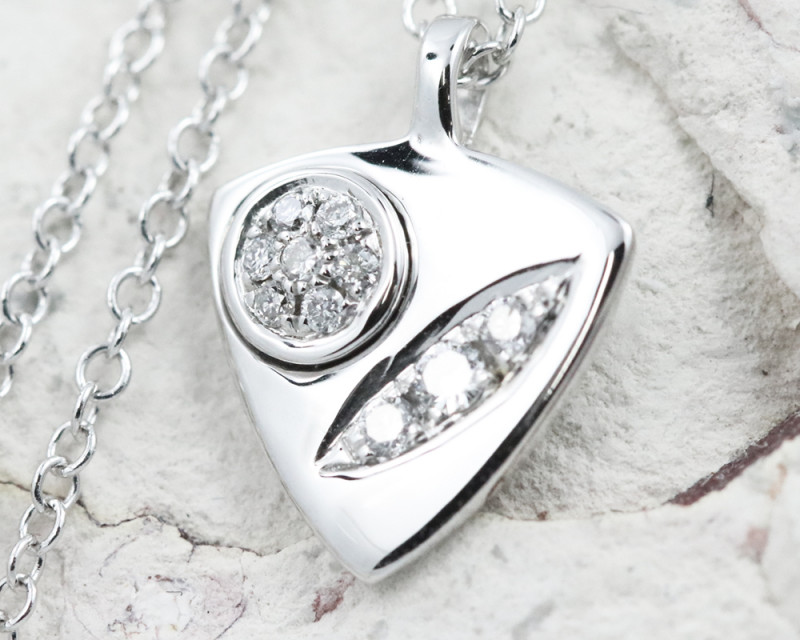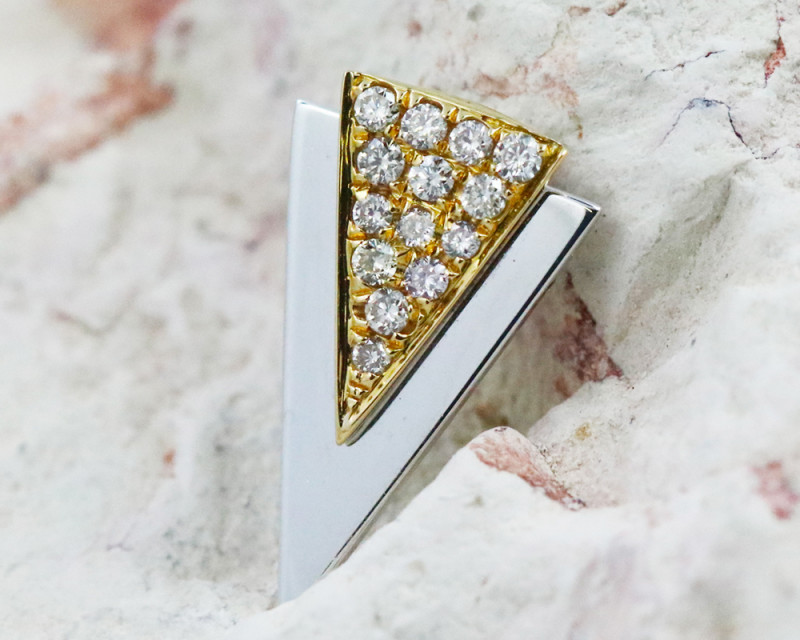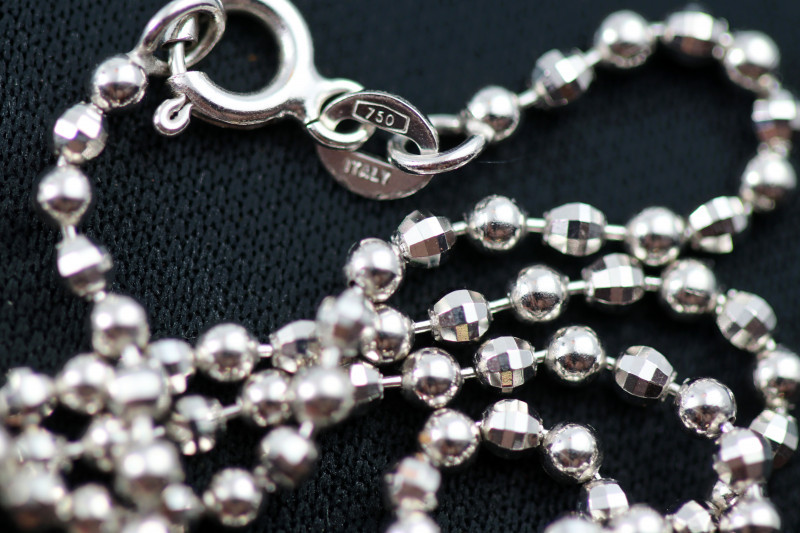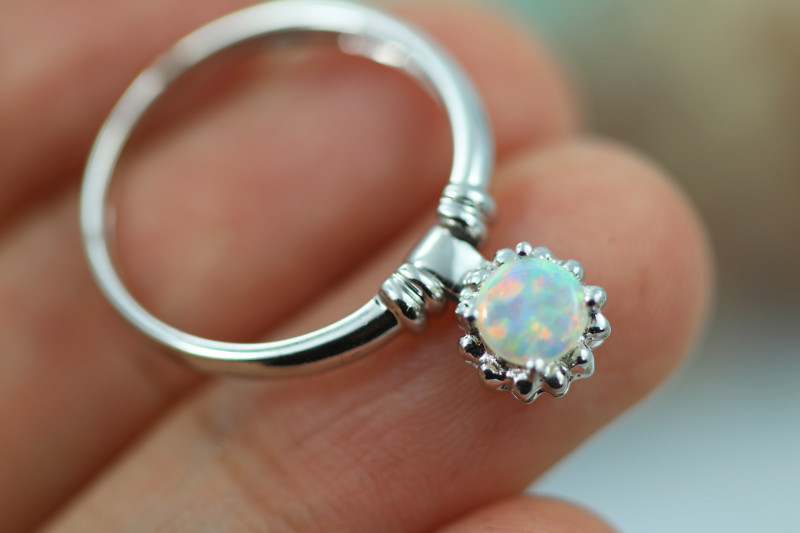
White Gold Jewelry: Understanding the Metal and its Popularity
 If you’re searching for a luxurious and elegant addition to your fine jewelry collection, white gold may be a perfect choice.
If you’re searching for a luxurious and elegant addition to your fine jewelry collection, white gold may be a perfect choice.
But is white gold actually gold? And what sets it apart from other popular options like yellow gold and platinum?
That’s what we’re here to uncover today.
So if the sophisticated and timeless world of white gold jewelry has piqued your interest, you’ve come to the right place!
Join us as we fill you in on everything white gold — from its unique characteristics and properties to its creation, care, value, and more.

What is White Gold Jewelry?
As the name implies, white gold is gold that’s… well, white.
It’s made by combining yellow gold with other white metals, such as palladium, nickel, or silver — but more on the creation process in a bit.
Is white gold good for jewelry? Yes!
Besides its obvious beauty, white gold is popular for jewelry because of its durability and resistance to tarnishing. It’s also less expensive than platinum, which has a similar look but a much steeper price tag.
Now, if we’re being totally honest, “natural” white gold technically doesn’t exist. It’s actually a man-made product created as a substitute for platinum.
But why?
To understand, we’d have to travel back in time and peer into white gold’s history.

The History of White Gold Jewelry
So why was white gold made as a platinum alternative?
You might think it’s because platinum is rare, with only about 40 ounces being mined each year — but that’s actually not the reason at all.
With a history dating as far back as ancient Egypt, platinum has long been coveted for its use in stunning rings, bracelets, and pendants. Historically, platinum pieces were considered the crème de la crème, reserved mainly for the upper crust due to their high cost.
The events of World War II, however, marked a significant shift. It was at this time that platinum’s durability was regarded as a strategic material and its use in non-military applications became prohibited.
So while the government stock-piled platinum resources, jewelers across America were banned from using it to create jewelry.
As the war waged, jewelers faced the challenge of finding an alternative metal with the same desirable qualities as platinum. Through experimentation, they discovered that mixing gold with different white metals (like nickel, palladium, or zinc) would lighten gold’s warm hue to a bright, platinum-like white.
Hence, white gold jewelry was born.
Going back, how does white gold fare against its muse?
 Pictured above: Platinum ring with cat's eye chrysoberyl and diamonds
Pictured above: Platinum ring with cat's eye chrysoberyl and diamonds
White Gold vs Platinum
Nowadays, platinum is once again in demand, but white gold remains a popular alternative and preferred favorite among many jewelry lovers.
For starters, white gold is about 4 times less expensive than pricy platinum. This is because you need more platinum to make a piece due to its high density — it’s about 60 percent denser than gold.
On the flip side, white gold isn’t as strong as platinum, making it more prone to scratches and other types of damage. But it’s also easier to work with than platinum, which can lower initial labor costs and later repair costs.
Another notable distinction is the differing standards by which they’re measured.
Perhaps it’s because white gold originated as a temporary substitute metal that there are no official, established guidelines for white gold in the jewelry industry. This results in many variations and multiple alloys being utilized in its creation.
Whereas platinum, on the other hand, is subject to the oversight of the Federal Trade Commission (FTC).
I guess no one thought white gold would stick around. The joke’s on them, huh?
So how exactly is white gold made?

How is White Gold Jewelry Made?
Although the FTC doesn’t provide specific guidelines for white gold jewelry, most manufacturers follow a consistent standard, resulting in a uniform look and feel among most white gold pieces.
We mentioned earlier that white gold is made by combining yellow gold with white metals. This is actually done for two reasons.
First, it dilutes gold’s natural yellow hues, creating the bright, striking white color for which white gold is prized. Secondly, it helps strengthen the white gold since pure 24K gold is naturally very soft and malleable — too soft for being worn regularly.
The most popular alloy mixtures generally contain some combination of the following:
Nickel
Titanium
Palladium
Zinc
Silver
The most common combination includes palladium, silver, nickel, or a combination of these. Nickel-gold alloys are less expensive, while palladium-gold alloys are more valuable.
The downside to white gold? Some individuals could experience an allergic reaction when wearing unplated gold-nickel alloy jewelry. In fact, nickel is the #1 allergen when it comes to jewelry.
That’s where white gold’s dazzling coating comes into play…

Rhodium-Plating
Almost all white gold jewelry is coated in a precious metal known as rhodium, a cousin of platinum.
Done via electroplating, rhodium plating adds an even more lustrous sheen and whiter hue. It also helps to protect white gold jewelry from scratching and protect your skin from potential allergens like nickel.
While white gold doesn’t tarnish, it’s possible that a yellow tint may start resurfacing over time — leaving many wondering: “why is my white gold turning yellow?”
This results from the rhodium plating wearing off from wear and tear. The rate at which this happens generally varies on a few factors, including your skin’s pH levels and the types of perfumes or chemicals your jewelry is exposed to.
But this is totally normal in white gold jewelry, and it’s an easy fix!
Just ask your jeweler to re-coat your white gold pieces with a new rhodium plating. Replating isn’t super expensive — generally $40 to $100 — and how often you do it is up to you!
Switching gears, let’s explore how much gold is actually in white gold.
White Gold Jewelry Karatage
The gold content of all gold jewelry — including yellow, white, and rose gold — is measured in karats. The term "karat,” commonly abbreviated as "K" or “Kt,” indicates the ratio of pure gold to added metals.
For instance, 9K gold is 37.5% pure gold, while 18K gold is 75% pure gold.
This holds true for white gold, regardless of which metals are added.
White gold is almost never available in 24 karats, as it must be mixed with other metals for wearability. Instead, you’ll typically find white gold in 14K or 18K, depending on the kind of jewelry.
In terms of quality, is white gold better than yellow gold? That depends!

Which is Better: White Gold or Yellow Gold?
Both white gold and yellow gold are beautiful, quality metals for your jewelry. But they do differ significantly in some aspects — mainly strength.
White gold jewelry, due to having stronger metals mixed in, tends to be more resistant to dents, scratches, and other damage. As such, it may be a more suitable choice if you have a super active lifestyle.
However, it’s worth noting that yellow gold offers its own advantages, like not needing eventual replating or replating after being resized.
As far as cost, is white gold worth buying over yellow gold?
White gold isn’t more expensive than yellow gold. Both are priced comparably so long as they’re hallmarked at the same karatage.
Whether white gold or yellow gold is better ultimately comes down to your preference and lifestyle.
Speaking of hallmarks, how can you tell if you have real white gold?

How to Identify White Gold Jewelry
If you have what you believe is white gold jewelry, there are a few ways to verify its authenticity:
Check the hallmark
Most white gold jewelry will be marked with a hallmark indicating its purity. For example, a hallmark of "14K" means the piece is 14 karat gold, or 58.5% pure gold.
Look for signs of wear
Since rhodium typically coats white gold, any visible signs of wear (such as scratches or discoloration) could signify that the rhodium coating has worn off, revealing the natural yellow color of the gold beneath.
Consult a professional jeweler
Your best bet for preventing damage to your jewelry and identifying whether it’s genuinely white gold is to consult a professional jeweler. They’ll be able to use their expertise and more advanced techniques (such as X-ray fluorescence) to give you an accurate answer.
Perform an acid test
Gold testing kits come with acid solution sets for different karat levels. The test usually calls for you to scratch a small, discreet area on the jewelry, exposing the metal underneath. You’d then apply a small drop of the acid solution corresponding to the karat level you think the jewelry is. If there’s no reaction, the jewelry is likely the karatage indicated by the acid solution.
Now that you know how to identify white gold, let’s turn to the topic of cost.

White Gold Jewelry Pricing
Why is some white gold cheaper than others? There are a few reasons you’ll see significant cost variations:
Gold content: Like all gold, the price of white gold mainly comes down to purity. In other words, the higher the purity (karats), the higher the price.
Market demand: If white gold is currently in high-demand, the price will be higher and vice versa.
Metal quality: Higher quality metals in the alloy (like palladium or platinum) may result in a higher price.
Brand and design: White gold jewelry from a well-known designer or brand will fetch higher prices than similar pieces from a lesser-known or generic brand.
Design complexity: A piece with intricate details or a more complex design will likely be more expensive than a simpler piece.
Read on for the answers to more questions we haven’t covered yet!

Frequently Asked Questions about White Gold Jewelry
Below, we've answered some of the most common questions about white gold jewelry:
How long does white gold last?
With proper care, you can wear white gold every day, and it’ll last for many years.
How do you clean white gold jewelry?
To clean white gold, soak it in water with mild soap for 5-10 mins. Gently remove any dirt or residue with a soft towel and rinse with clean water. Gently but thoroughly pat dry with a soft cloth.
How should you store white gold jewelry?
Store your white gold pieces in a fabric-lined jewelry box or pouch away from high (or fluctuating) temperatures and bright light. You may want to keep white gold jewelry in its own pouch or plastic bag to avoid scratches.
Can you shower wearing white gold?
Hard water, harsh soaps, and abrasive scrubbing can cause the rhodium plating to wear faster on your white gold jewelry. Therefore, it’s best to remove your white gold pieces before showering.
What should you avoid exposing your white gold jewelry to?
Because of its rhodium plating, white gold requires a bit more maintenance than other types of gold. To preserve your pieces, avoid letting them come into contact with strong chemicals and abrasives.
What are the advantages of white gold?
Some benefits of white gold include being:
Malleable and easy for jewelers to shape
Bright metal with beautiful, neutral color
Affordable and widely available
Suited to almost every aesthetic and gemstone
Easy to repair, resize, solder, and polish
What are the disadvantages of white gold?
Some disadvantages of white gold are:
The rhodium plating on white gold does fade, requiring eventual replating
It’s durable but can scratch with heavy, frequent wear
Some alloys may cause skin irritation in those allergic to nickel

Is White Gold Jewelry For Me?
White gold is an exquisite option for those seeking a timeless and sophisticated piece of jewelry. Its versatility, durability, and typically hypoallergenic properties make it an excellent choice for a wide range of pieces, from engagement rings to gemstone-adorned jewelry.
Ready to elevate your collection with a touch of white gold glamor?
Search the Fashion Encyclopedia
Related Auctions
Related Articles
How to Buy Jewelry on the Internet. There are so many types of beads. It will be up to you to determine where you want to start, all authentic gemstone beads or if you will also use glass beads ‘man made’ as well as gold and silver beading. You
10th Apr 2019
A simple guide for understanding gold hallmarks, how to identify them and the methods for testing gold purity.
13th Jun 2019
Jewelry coupons help buyers come back for more discounts for gemstone jewlery
10th Apr 2019
Latest Articles
Titanium is a popular jewelry metal known for being lightweight, durable, and affordable. Learn all about titanium, how it compares to similar metals, and the pros and cons of titanium jewelry.
7th Feb 2023
Learn all about tungsten jewelry - from its history and uses to its durability and care. By the end of our guide, you’ll know if tungsten is right for you!
7th Feb 2023
Gold jewelry comes in many shades, but yellow gold is the most popular, classic option. Learn what yellow gold means, the types of gold jewelry, and what to know before buying yellow gold jewelry.
26th Jan 2023




